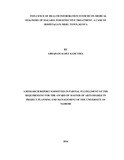| dc.description.abstract | Information systems are being embraced as tools of better service delivery, efficiency and accountability in many sectors including healthcare. Medical diagnostic reports are crucial in treatment and prognosis of diseases, thus the importance of precise and accurate medical data. Various interventions and measures have been undertaken globally in the fight against malaria with notable gains, including Kenya. The introduction of rapid diagnostic testing kits for malaria in Kenya presents a novel way of testing. However, the problem lies in translation of the malaria results done through rapid diagnostic tests to accurate data due to transcription errors as well as medical biases. Inaccurate medical data negatively impacts health interventions and policy. Therefore this study sought to investigate the influence of health information systems on medical diagnosis of malaria for effective treatment in, Meru town, Imenti North constituency, Meru County. The research design was of descriptive survey research design .This was because the design was useful since it collected data from members of the population in order to determine the current status without manipulating the variables. The study consisted of a population of 30 respondents from the Karen Hospital, Aga khan Hospital, Grace Park Hospital and Meru teaching and referral hospital in Meru town .The respondents and interviewees consisted of medical officers, laboratory technologists, pharmaceutical technologists, clinical officers, nurses, radiographers, physiotherapists, accountants and hospital administrators. Quantitative data was analyzed using the SPSS version 21 and tabulated into frequency tables and percentages. This study employed correlation coefficient inferential statistics to bring out the relationship between the dependent and independent variables. Qualitative data was analyzed by organizing according to the research questions and objectives. It was implied in the study that availability of a hospital information system influenced the ease of access and management of patient data; the forms of registration were varied, attributed to difference in scope of hospital clientele. The higher the scope of hospital clientele, the more integrated the system was. The level of integration decreased with lower hospital clientele base. The study established that a reliable and effective network influenced the quality of service rendered by the hospital information system. Hospital information systems improved accessibility of medical records as well as enabled tracking and use of health data by medical personnel. Hospital information systems influenced decision making in treatment of malaria through shortened treatment times. Based on the findings, the study suggested that older users should be encouraged to utilize the system through specialized training programmes; standardization of hospital information systems to enhance quality of health service delivery and improved resource allocation for realization of the full potential of hospital information systems. The study suggested further research how levels of competence of information technology influences use of hospital information systems; investigation of how health information system integration influences quality of medical data and further studies on the contribution of hospital information systems on disease surveillance. | en_US |



